Experimental Study on Aeroelastic Instability of Spherical Inflatable Membrane Structures with a Large Rise–Span Ratio
Abstract
:1. Introduction
2. Wind Tunnel Test on the Aeroelastic Model
2.1. Design of the Aeroelastic Model
2.2. Manufacture of the Aeroelastic Model
2.3. Measurement Instruments
2.4. Test Cases
3. Wind-Induced Response Characteristics
3.1. Data Processing
3.2. Distribution Characteristics of Wind-Induced Response
3.3. Statistics of Wind-Induced Response
4. Aeroelastic Instability Analysis
4.1. Modal Identification and Analysis
4.2. Damping Ratio Analysis
4.3. Dimensionless Critical Wind Speed of Aeroelastic Instability
5. Conclusions
- The maximum windward displacement of the structure is located at approximately 1/2 of the windward. The extreme value of the mean value of the total displacement occurs at approximately 1/2 of the centerline of the windward. The extreme value of the mean value of the maximum principal strain occurs at the top region of the model and approximately 1/2 of the windward and leeward.
- The average deformation characteristic of the spherical inflatable membrane is that the top, windward, and side deform upward, downward, and outward. The deformation of the structure is large in the downwind, cross-wind, and vertical directions. The amplitude of the cross-wind direction is always larger than the other two directions. The structure is greatly affected by the vortex-induced vibration caused by the FSI. Therefore, the FSI should be considered in the engineering design of similar structures.
- The aeroelastic instability of the spherical inflatable membrane structure is caused by the cross-wind vortex-induced resonance, which is marked by the sudden change of the structural response and amplitude when the critical wind speed is reached or exceeded.
- After reaching the critical wind speed (when .37), the structure usually undergoes a change of the dominant vibration mode. Furthermore, as the wind speed continues to increase, the damping ratio decreases rapidly and eventually decays to close to zero.
- Based on the study in this paper, the dimensionless critical wind speed of the spherical inflatable membrane structure is approximately 1.37. The Reynolds number of fluid flow after reaching the instability critical wind speed is Re > 3.1 × 105.
Author Contributions
Funding
Institutional Review Board Statement
Informed Consent Statement
Data Availability Statement
Conflicts of Interest
References
- Park, M.J.; Yoon, S.W.; Kim, Y.C.; Cheon, D.J. Wind Pressure Characteristics Based on the Rise–Span Ratio of Spherical Domes with Openings on the Roof. J. Build. 2022, 12, 576. [Google Scholar] [CrossRef]
- Michalski, A.; Kermel, P.D.; Haug, E.; Löhner, R.; Wüchner, R.; Bletzinger, K.-U. Validation of the computational fluid–structure interaction simulation at real-scale tests of a flexible 29m umbrella in natural wind flow. J. Wind. Eng. Ind. Aerodyn. 2011, 99, 400–413. [Google Scholar] [CrossRef]
- Wu, Y.; Chen, Z.-Q.; Sun, X.-Y. Research on the wind-induced aero-elastic response of closed-type saddle-shaped tensioned membrane models. J. Zhejiang Univ. Sci. A 2015, 16, 656–668. [Google Scholar] [CrossRef]
- Li, T.; Yang, Q.; Ishihara, T. Unsteady aerodynamic characteristics of long-span roofs under forced excitation. J. Wind Eng. Ind. Aerodyn. 2018, 181, 46–60. [Google Scholar] [CrossRef]
- Takadate, Y.; Uematsu, Y. Steady and unsteady aerodynamic forces on a long-span membrane structure. J. Wind Eng. Ind. Aerodyn. 2019, 193, 103946. [Google Scholar] [CrossRef]
- Liu, C.; Deng, X.; Zheng, Z. Nonlinear wind-induced aerodynamic stability of orthotropic saddle membrane structures. J. Wind Eng. Ind. Aerodyn. 2017, 164, 119–127. [Google Scholar] [CrossRef]
- Ding, W.; Uematsu, Y.; Nakamura, M.; Tanaka, S. Unsteady aerodynamic forces on a vibrating long-span curved roof. J. Wind Struct. 2014, 19, 649–663. [Google Scholar] [CrossRef]
- Ding, W.; Uematsu, Y. Large eddy simulation of unsteady aerodynamic behavior of long-span vaulted roofs. J. Zhejiang Univ. Sci. A 2017, 18, 793–806. [Google Scholar] [CrossRef]
- Chen, Z.Q.; Wu, Y.; Sun, X.Y. Research on aeroelastic instability mechanism of closed-type one-way tensioned membrane. J. Build. Struct. 2015, 36, 12–19. (In Chinese) [Google Scholar]
- Newman, B.; Ganguli, U.; Shrivastava, S. Flow over spherical inflated buildings. J. Wind Eng. Ind. Aerodyn. 1984, 17, 305–327. [Google Scholar] [CrossRef]
- He, Y.; Shen, J. The wind response of double layer membrane gas holders when considering the effect of FSI. J. Int. Assoc. Shell Spat. Struct. 2017, 58, 125–135. [Google Scholar] [CrossRef]
- Tavakol, M.M.; Yaghoubi, M.; Motlagh, M.M. Air flow aerodynamic on a wall-mounted hemisphere for various turbulent boundary layers. J. Exp. Therm. Fluid Sci. 2010, 34, 538–553. [Google Scholar] [CrossRef]
- Tavakol, M.M.; Abouali, O.; Yaghoubi, M. Large eddy simulation of turbulent flow around a wall mounted hemisphere. J. Appl. Math. Model. 2014, 55, 3596–3618. [Google Scholar] [CrossRef]
- Mokin, N.A.; Kustov, A.A.; Trushin, S.I. Numerical simulation of an air-supported structure in the air flow. In Proceedings of the Structural Membranes: VIII International Conference on Textile Composites and Inflatable Structures, Munich, Germany, 9–11 October 2017. [Google Scholar]
- Wood, J.N.; Breuer, M.; Nayer, G.D. Experimental studies on the transient fluid–structure interaction of an air-inflated flexible membrane in turbulent flow. J. Fluid Struct. 2018, 80, 405–440. [Google Scholar] [CrossRef]
- Nayer, G.D.; Apostolatos, A.; Wood, J.N.; Bletzinger, K.U.; Wüchner, R.; Breuer, M. Numerical studies on the transient fluid–structure interaction of an air-inflated flexible membrane in turbulent flow. J. Fluid Struct. 2018, 82, 577–609. [Google Scholar] [CrossRef]
- De Nayer, G.; Breuer, M.; Boulbrachene, K. FSI simulations of wind gusts impacting an air-inflated flexible membrane at Re = 100,000. J. Fluid Struct. 2022, 109, 103462. [Google Scholar] [CrossRef]
- Zhao, B.; Hu, J.; Chen, W.; Chen, J.; Jing, Z. Dynamic geometrical shape measurement and structural analysis of inflatable membrane structures using a low-cost three-camera system. J. Autom. Constr. 2018, 96, 442–456. [Google Scholar] [CrossRef]
- Zhao, B.; Hu, J.; Chen, W.; Chen, J.; Qiu, Z.; Jing, Z. Computational method for in-situ finite element modeling of inflatable membrane structures based on geometrical shape measurement using photogrammetry. J. Comput. Struct. 2019, 224, 106105. [Google Scholar] [CrossRef]
- Rizzo, F.; Kopp, G.A.; Giaccu, G.F. Investigation of wind-induced dynamics of a cable net roof with aeroelastic wind tunnel tests. J. Eng. Struct. 2021, 229, 111569. [Google Scholar] [CrossRef]
- Tryggvason, B.V. Aeroelastic modeling of pneumatic and tensioned fabric structures. In Proceedings of the 5th International Conference on Wind Engineering, Fort Collins, CO, USA, 8–14 July 1979. [Google Scholar]
- Matsumoto, T. Aeroelastic modelling of air-supported roofs. J. Wind Eng. Ind. Aerodyn. 1992, 41–44, 1497–1507. [Google Scholar] [CrossRef]
- Cheng, C.M.; Fu, C.L. Characteristic of wind loads on a hemispherical dome in smooth flow and turbulent boundary layer flow. J. Wind Eng. Ind. Aerodyn. 2010, 98, 328–344. [Google Scholar] [CrossRef]
- San, B.; Yang, Q.; Yin, L. Stochastic and sensitivity analysis of shape error of inflatable antenna reflectors. J. Acta Astronaut. 2016, 132, 170–176. [Google Scholar] [CrossRef]
- Li, D.; Lai, Z.-C.; Wang, Y.; Zheng, Z.-L. A non-contact method for estimating the pre-tension of a rectangular membrane structure. J. Insight Non-Destr. Test. Cond. Monit. 2020, 62, 464–470. [Google Scholar] [CrossRef]
- Zheng, Z.-L.; Tian, Y.; Li, D.; Liu, C.-J. Tearing behavior of membrane coated fabrics based on the DIC method under the effect of initial crack length. J. Mater. Test. 2019, 61, 41–48. [Google Scholar] [CrossRef]
- Sun, X.; Wu, H.; Shan, B. Application of stereovision on a saddle-shaped membrane structure in aero-elastic wind tunnel test. J. Rev. Sci. Instrum. 2020, 91, 035104. [Google Scholar] [CrossRef] [PubMed]
- Sun, X.; Wu, H.; Wu, Y. Vibration monitoring of an open-type one-way tensioned membrane structure based on stereovision. J. Rev. Sci. Instrum. 2019, 90, 075112. [Google Scholar] [CrossRef]
- Zhou, Y.; Li, Y.; Shen, Z.; Wang, L.; Tamura, Y. Numerical analysis of added mass for open flat membrane vibrating in still air using the boundary element method. J. Wind Eng. Ind. Aerodyn. 2014, 131, 100–111. [Google Scholar] [CrossRef]
- Hao, W.; Yang, Q. Applicability of random decrement technique in extracting aerodynamic damping of crosswind-excited tall buildings. J. Build. Eng. 2021, 38, 102248. [Google Scholar] [CrossRef]
- Derife, M.; Atmani, A.; Laasri, E.H.A.; Biallah, A.M.; Agliz, D. Identification of modal parameters by the random decrement method. J. Mater. Today Proc. 2022, 58, 1074–1080. [Google Scholar] [CrossRef]
- Derife, M.; Atmani, A.; Laasri, E.H.A.; Balil, J.; Agliz, D. Development of a low cost system for modal parameters identification under ambient vibration: A low rise building as a case study. J. Build. Eng. 2022, 54, 104626. [Google Scholar] [CrossRef]

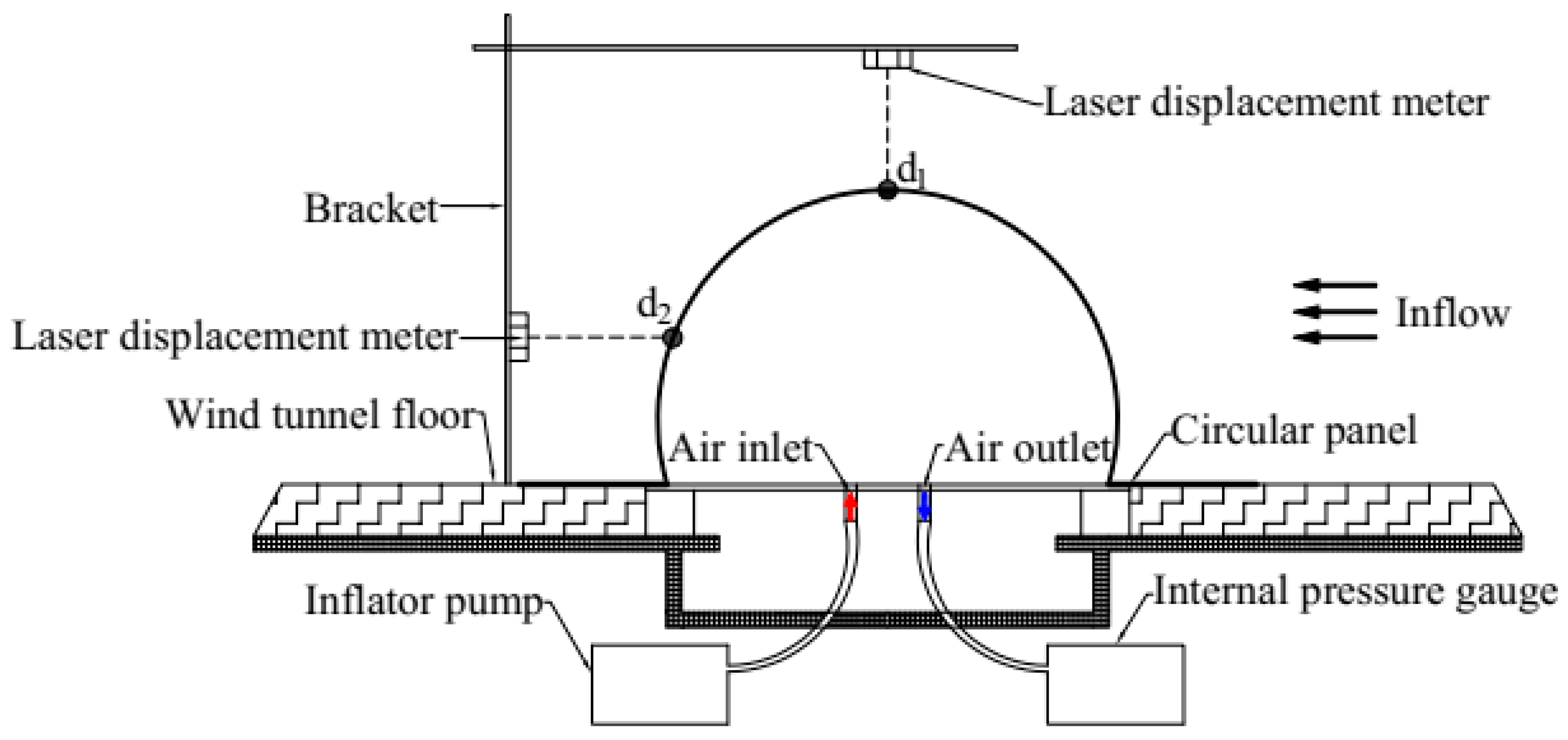
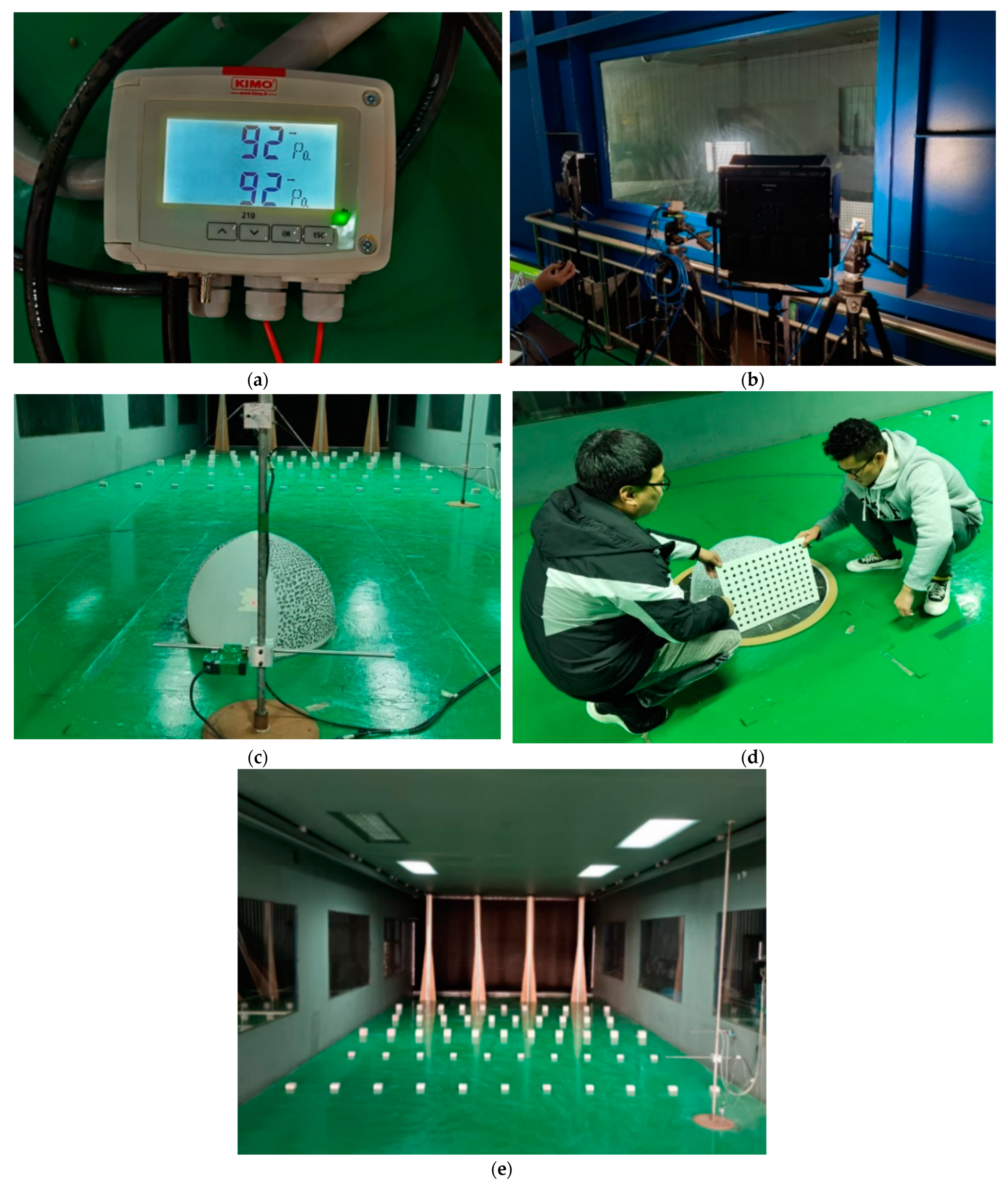
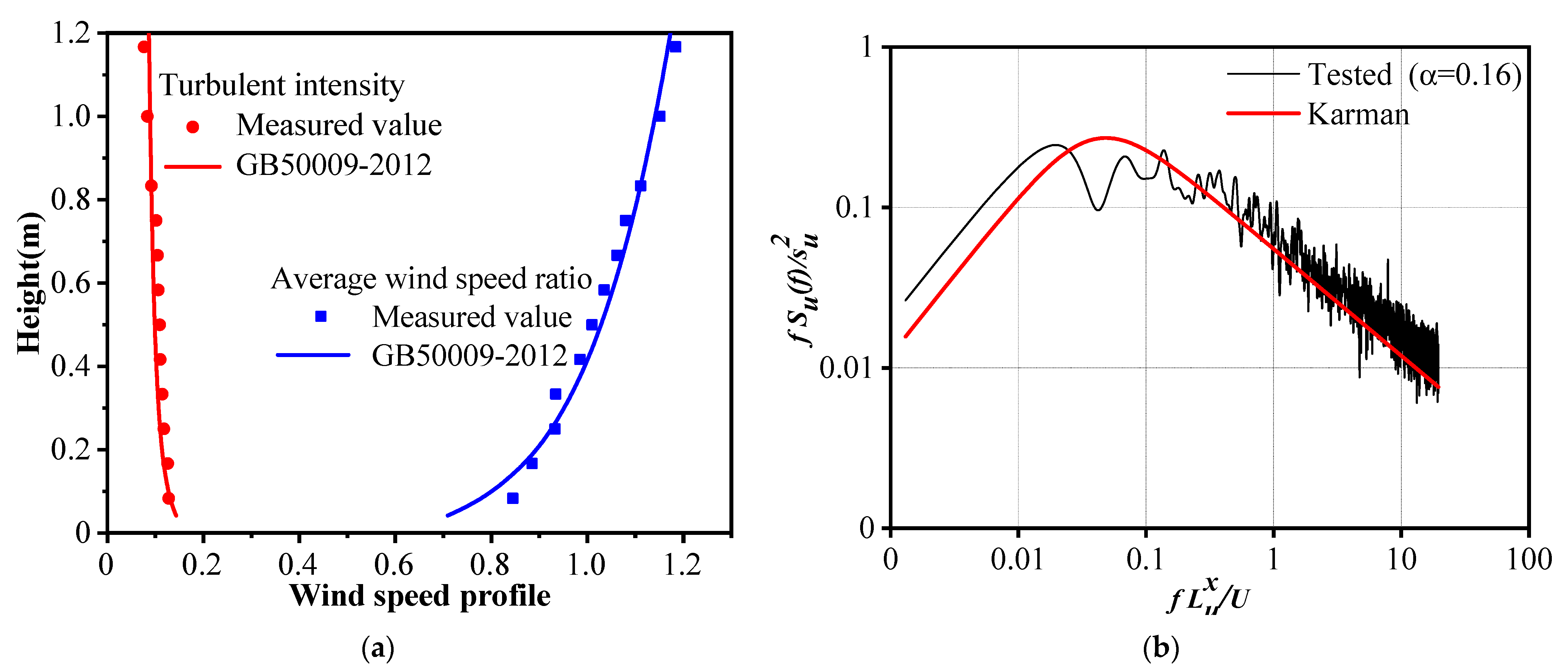

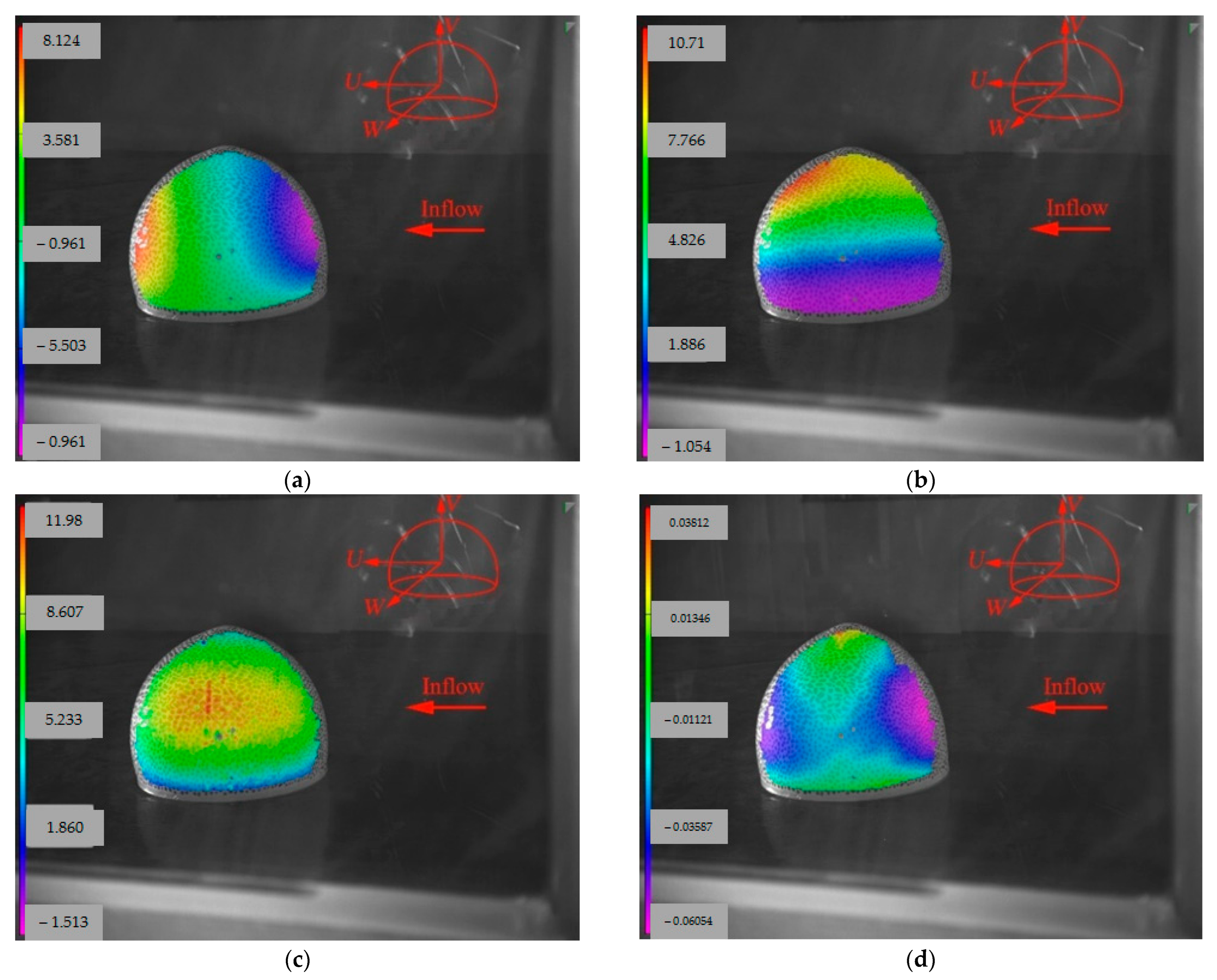
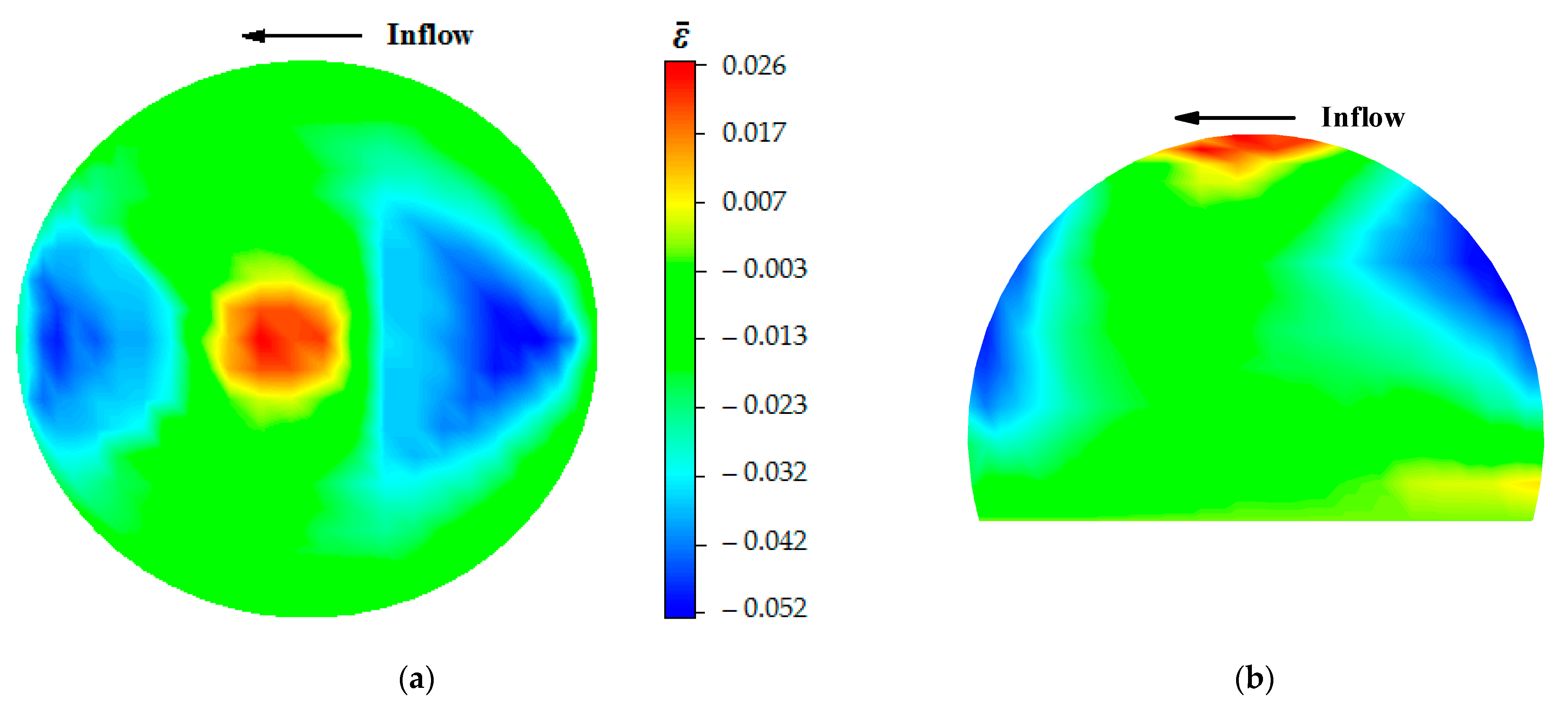
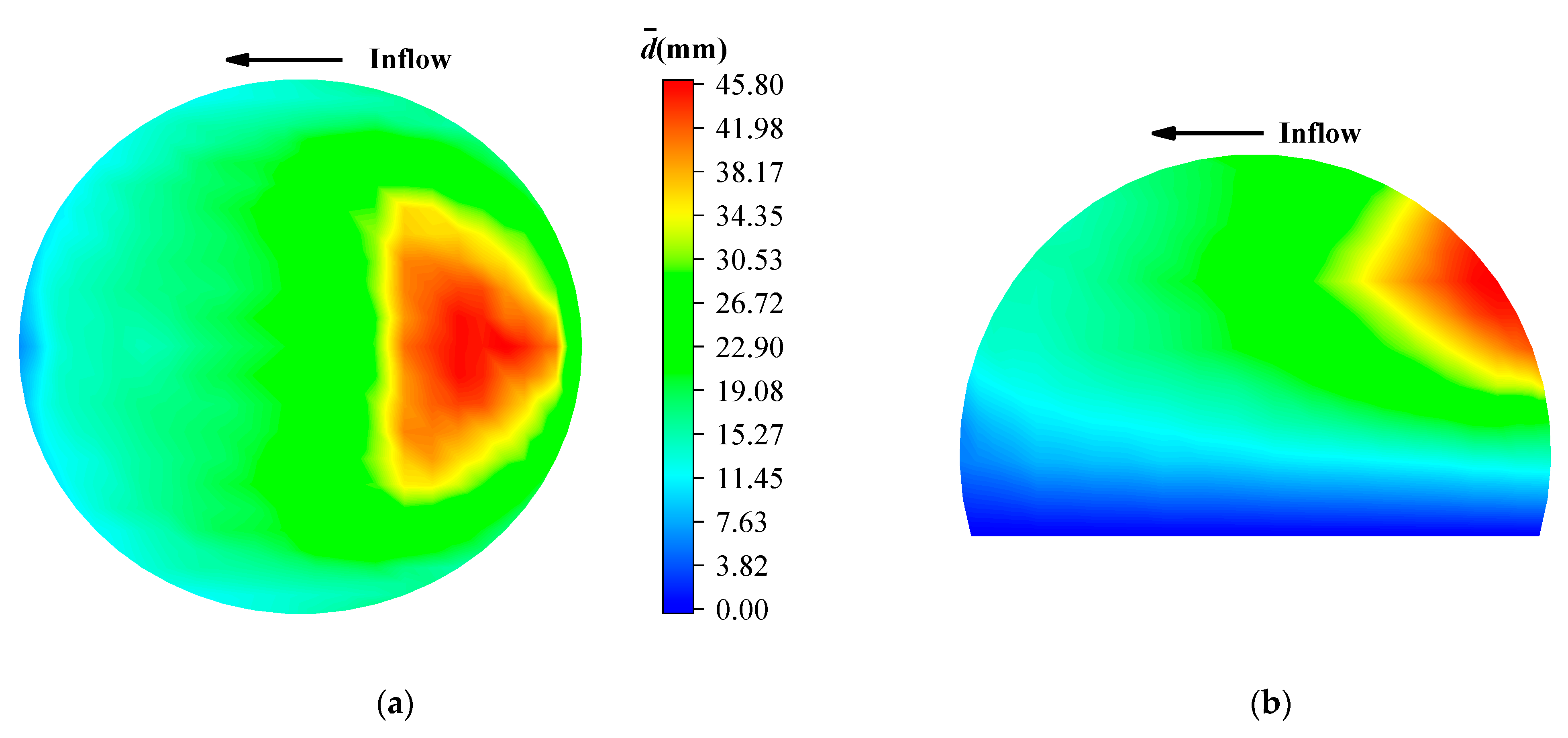
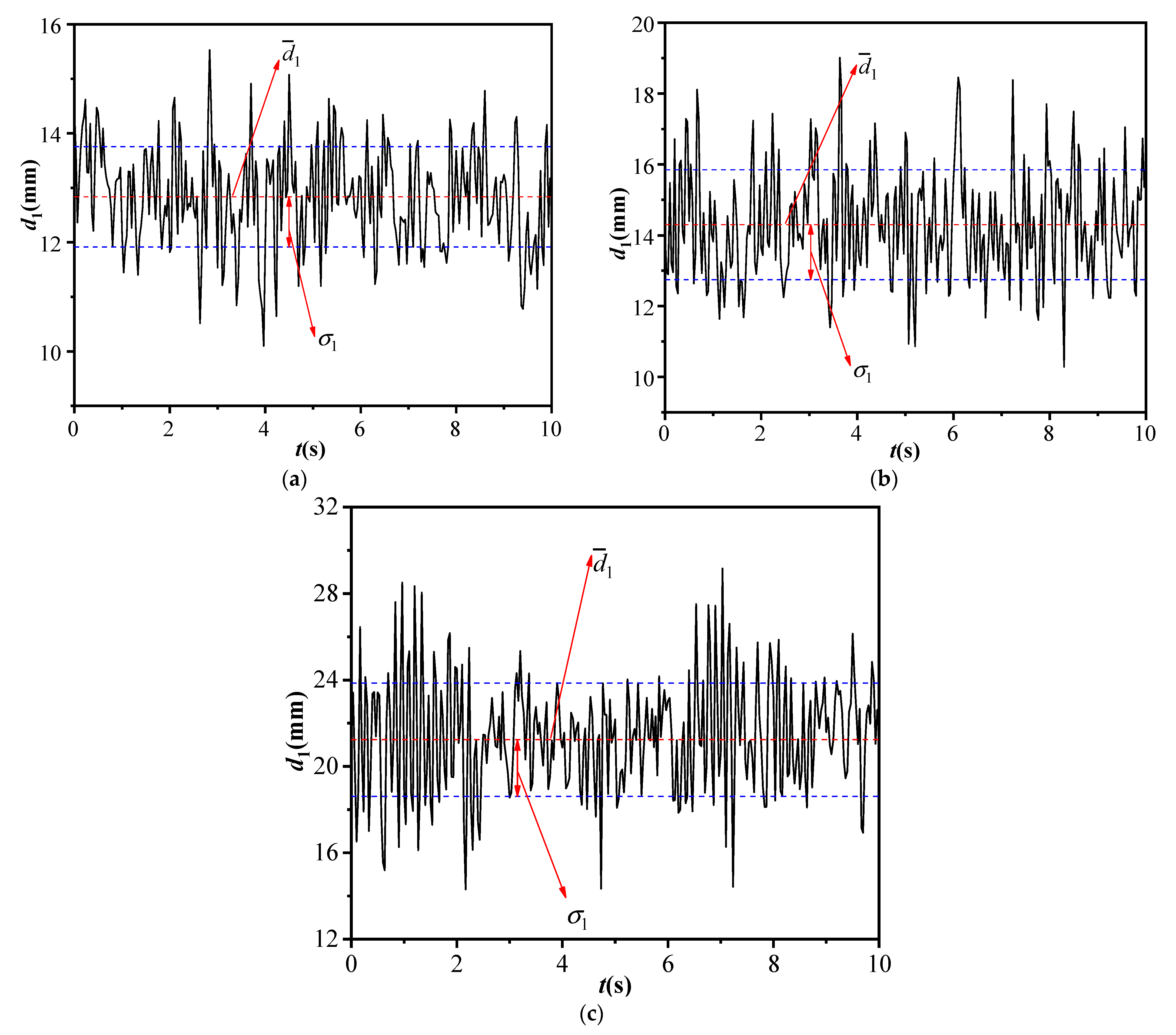

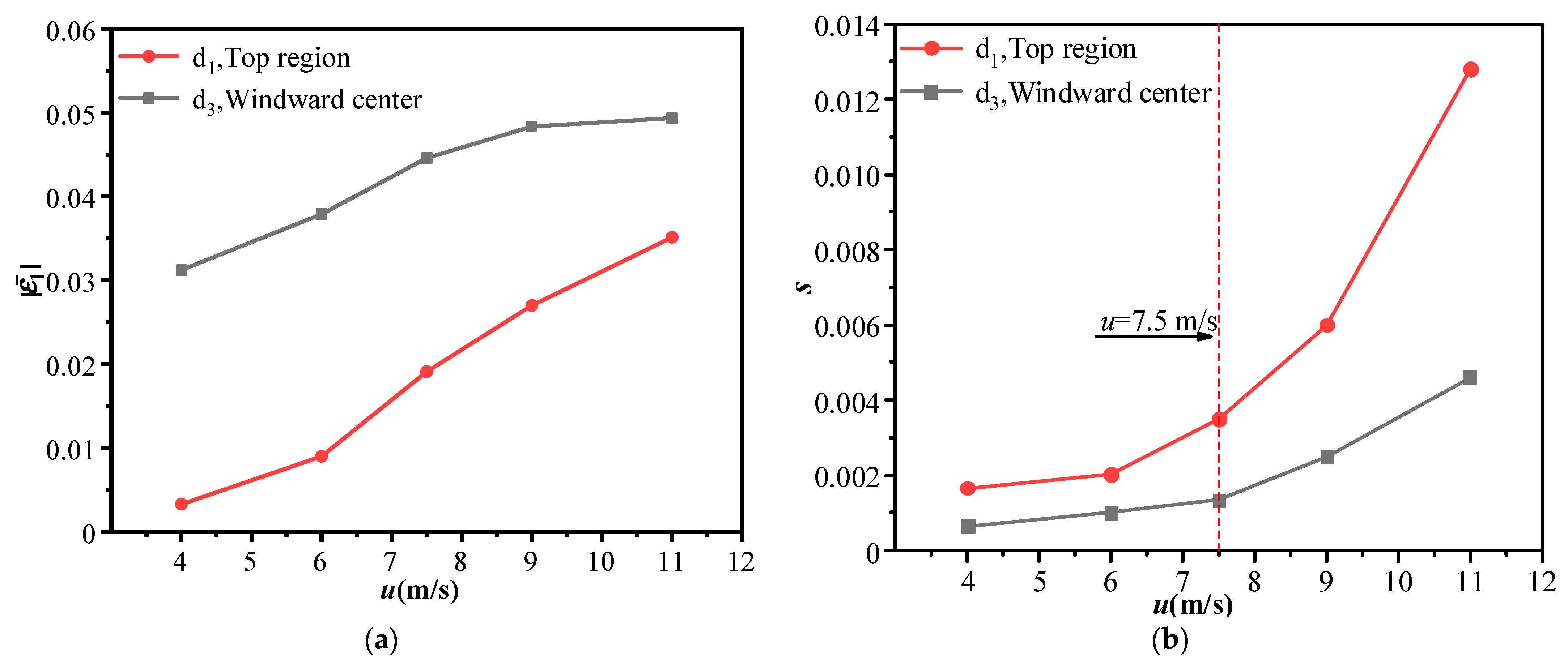
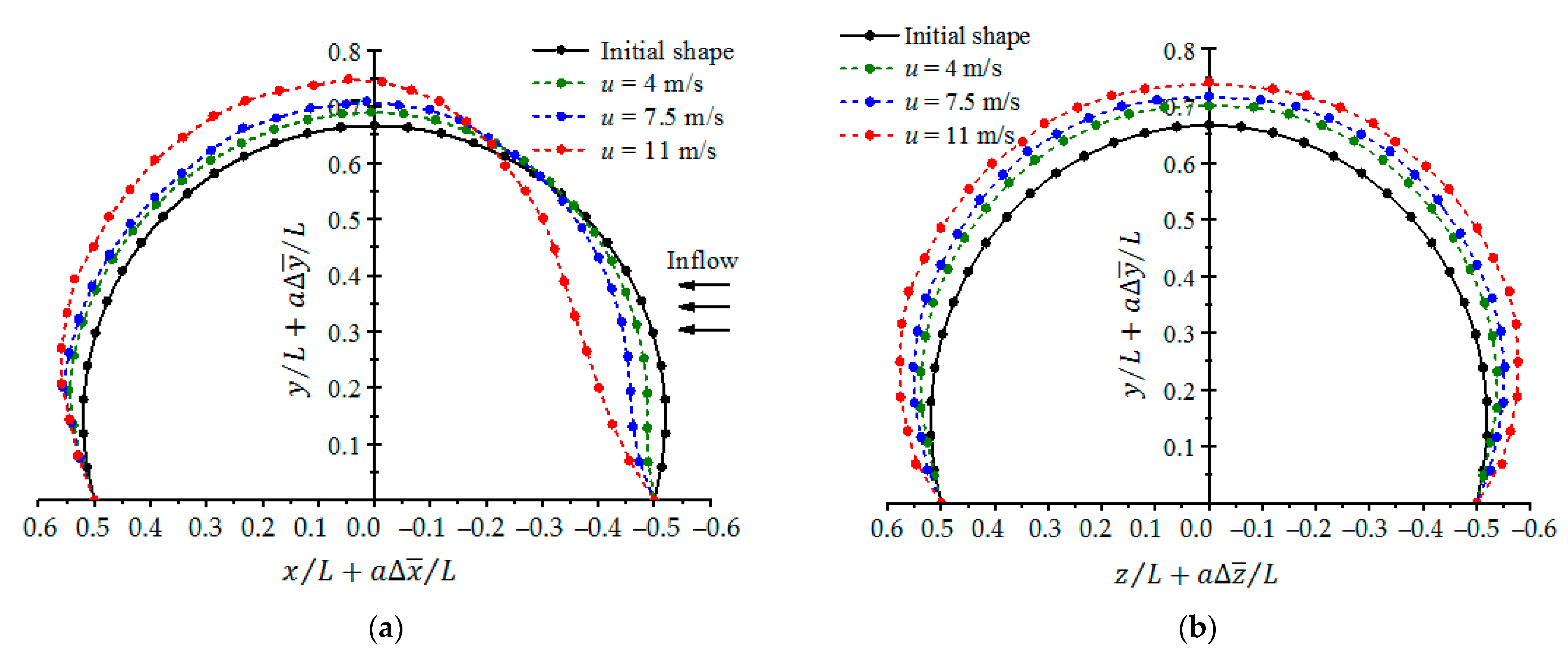





| Scale Ratio | Symbol | Theoretical Scale Ratio | Actual Scale Ratio |
|---|---|---|---|
| Length ratio | 1:100 | 1:100 | |
| Wind speed ratio | 1:1 | 1:1 | |
| Mass ratio of membrane | 1:100 | 1:10.6 | |
| Elastic stiffness ratio | 1:100 | 1:3.5 | |
| Internal pressure ratio | 1:1 | 1:2 | |
| Frequency ratio | 100:1 | 10:1 | |
| Displacement ratio | 1:100 | 1:100 | |
| Enclosed volume ratio | |||
| Froude number | 1 | ||
| Reynolds number | 1 |
| Measurement | Measurement Position | Equipment | Frequency (Hz) | Wind Speed (m/s) |
|---|---|---|---|---|
| Laser displacement meter vibration measurement | Top and middle of leeward side displacement (denoted as d1 and d2 in Figure 1) | Panasonic HL-C2 | 1024 | U = 4, 6, 7.5, 9, 11 |
| Full-field dynamic displacement and strain measurement | Full membrane surface strain | Matchid system | 30 |
Publisher’s Note: MDPI stays neutral with regard to jurisdictional claims in published maps and institutional affiliations. |
© 2022 by the authors. Licensee MDPI, Basel, Switzerland. This article is an open access article distributed under the terms and conditions of the Creative Commons Attribution (CC BY) license (https://creativecommons.org/licenses/by/4.0/).
Share and Cite
Chen, Z.; Su, Y.; Wang, J.; Su, N.; Tang, L. Experimental Study on Aeroelastic Instability of Spherical Inflatable Membrane Structures with a Large Rise–Span Ratio. Buildings 2022, 12, 1336. https://doi.org/10.3390/buildings12091336
Chen Z, Su Y, Wang J, Su N, Tang L. Experimental Study on Aeroelastic Instability of Spherical Inflatable Membrane Structures with a Large Rise–Span Ratio. Buildings. 2022; 12(9):1336. https://doi.org/10.3390/buildings12091336
Chicago/Turabian StyleChen, Zhaoqing, Yong Su, Junchao Wang, Ning Su, and Lixiang Tang. 2022. "Experimental Study on Aeroelastic Instability of Spherical Inflatable Membrane Structures with a Large Rise–Span Ratio" Buildings 12, no. 9: 1336. https://doi.org/10.3390/buildings12091336






